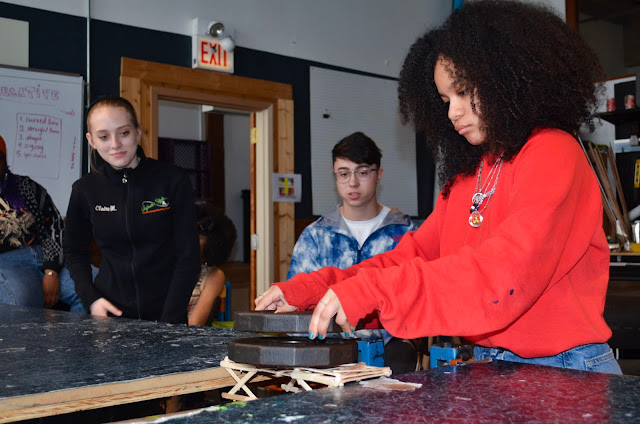Pinhole Photography
This Winter 2019 term for our Steam class is Light, Sound, and Time. The first unit focused on Light and the overall goal was to construct a pinhole camera and use it. We researched the anatomy of the eye, its functions and evolution. A guiding question in this course was Is light a particle or wave? We dwelled in colorblindness, frequencies, waves, types of light bulbs and important equations; such as, the speed of light being wavelength times frequency. A main aspect of our learning included the Unit Circle, a circle that has a radius of one and coordinate values are (cosine theta, sine theta). We used this to graph sine waves compared to cosine waves. We calculated degrees and radians within the circle and connected it to the movement of waves. Our field experience consisted of going to the school Latin, where we learned how to capture a picture using a pinhole camera. We did the Darkroom process ourselves with the help of the instructor. Our camera had to be completely dark except for the small hole that would focus light on the film inside. It functions when the image emitting light in front of the camera is inverted and reversed from that light peering through the hole onto the film inside. If too much light enters, the picture will be overexposed, and too little means an underexposed picture.
The piece of tape above the pinhole functions as the shutter. When film is place inside the camera in the Darkroom, I closed the shutter and held it shut so light couldn't enter. I had a set up of an artificial plant, some figures and archaic styled objects as a scene for my picture. Then, after a three minute wait of leaving the shutter open, this is how it turned out:
My camera does not demonstrate refraction nor reflection since it is a straightforward image projected by light. I took measurements of my camera's set up to calculate the distance from the objects to the camera, light rays orientation and shutter speed. I did this using trigonometry:
Pinhole height: 4.5 in
From pinhole to film: 4.8 in
Height of object: 13.4 in
When we finished our pinhole photography, with our extra time we created photo-grams. This was when we placed objects on film paper, brought it into the darkroom and shined light onto it for five seconds. Then we swept off the objects and began developing the paper. It captures the silhouette of the objects placed from the light. This is how mine turned out:
| Pinhole Camera, PKA 2019 |
The piece of tape above the pinhole functions as the shutter. When film is place inside the camera in the Darkroom, I closed the shutter and held it shut so light couldn't enter. I had a set up of an artificial plant, some figures and archaic styled objects as a scene for my picture. Then, after a three minute wait of leaving the shutter open, this is how it turned out:
| Pinhole Photograph, PKA 2019 |
Pinhole height: 4.5 in
From pinhole to film: 4.8 in
Height of object: 13.4 in
When we finished our pinhole photography, with our extra time we created photo-grams. This was when we placed objects on film paper, brought it into the darkroom and shined light onto it for five seconds. Then we swept off the objects and began developing the paper. It captures the silhouette of the objects placed from the light. This is how mine turned out:
 |
| Customs, PKA, 2019 |
In conclusion, this project taught me a new skill that I can use in the future without purchasing expensive equipment. Understanding the origins of how photography has developed connects to how the eye takes in images, and how we capture the world around us.

Comments
Post a Comment